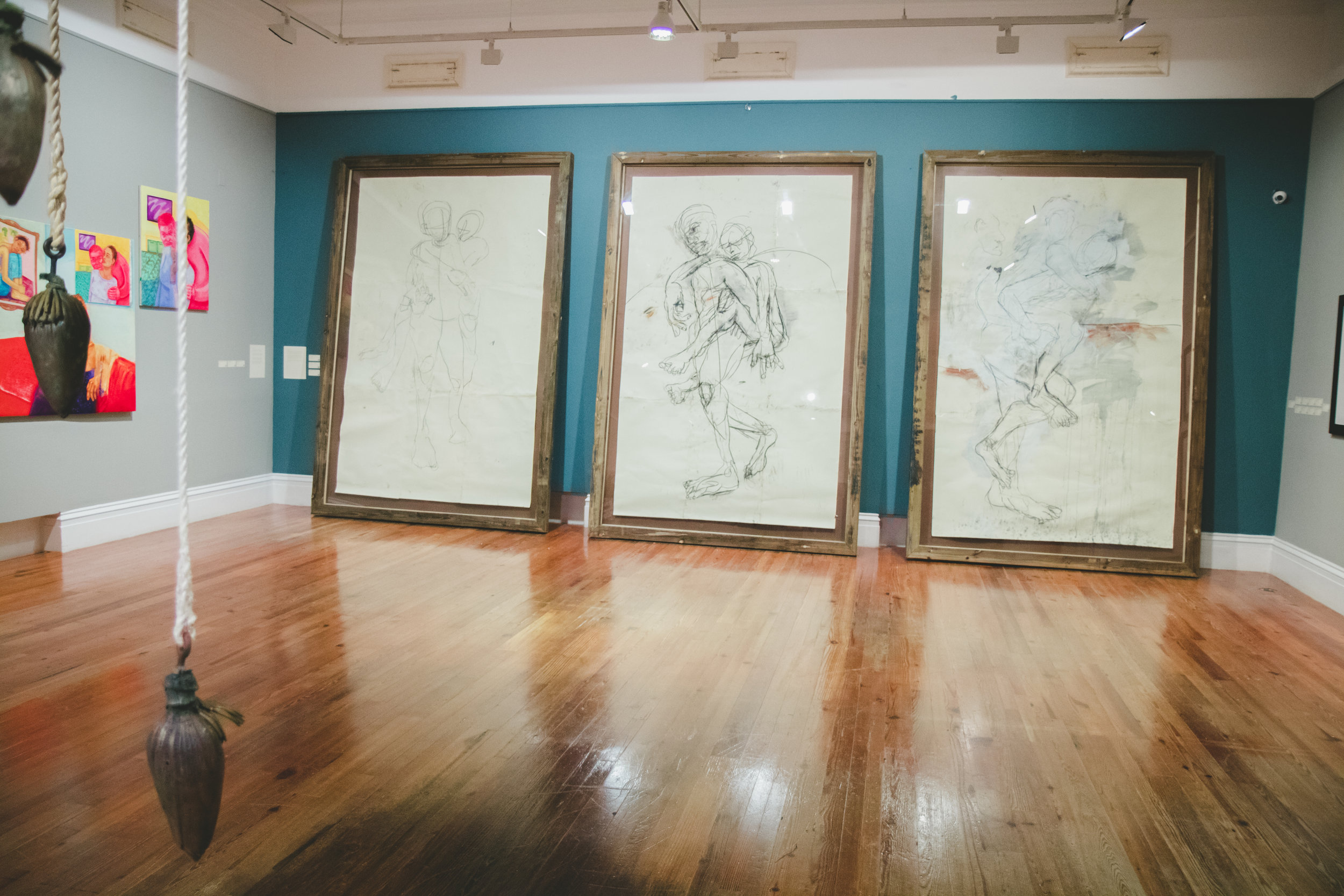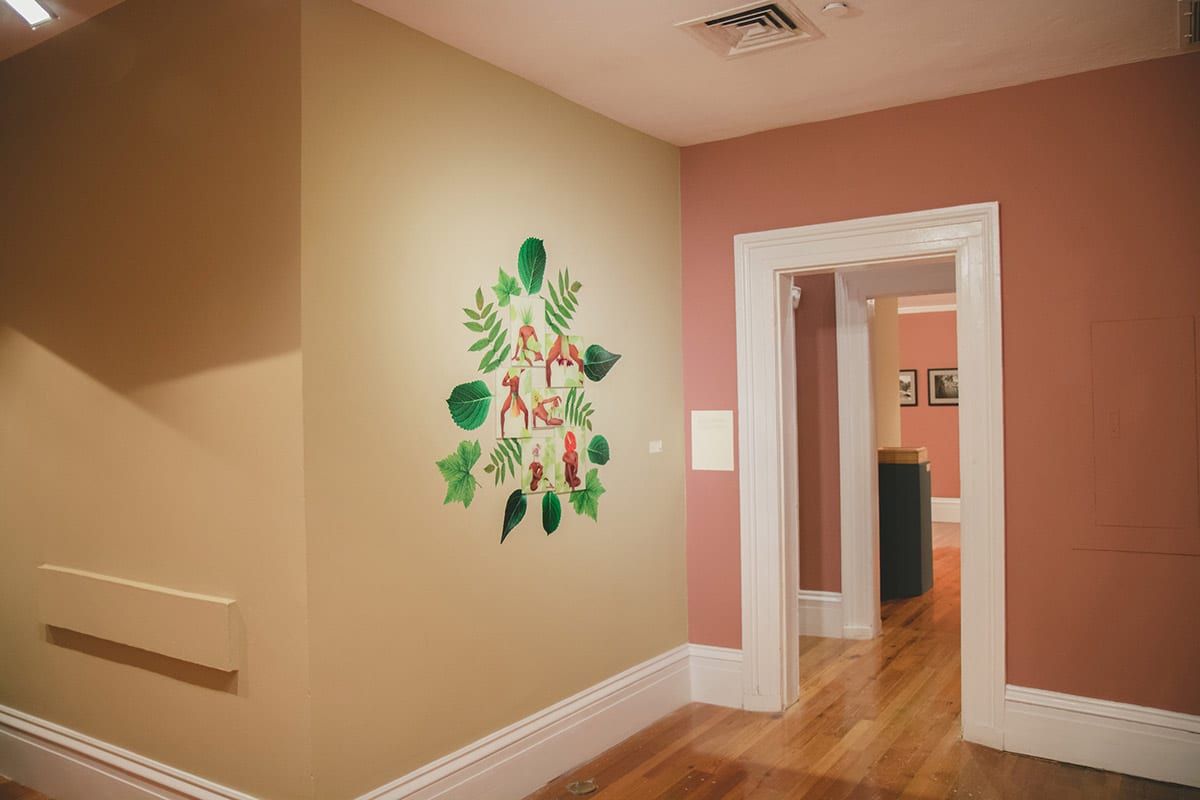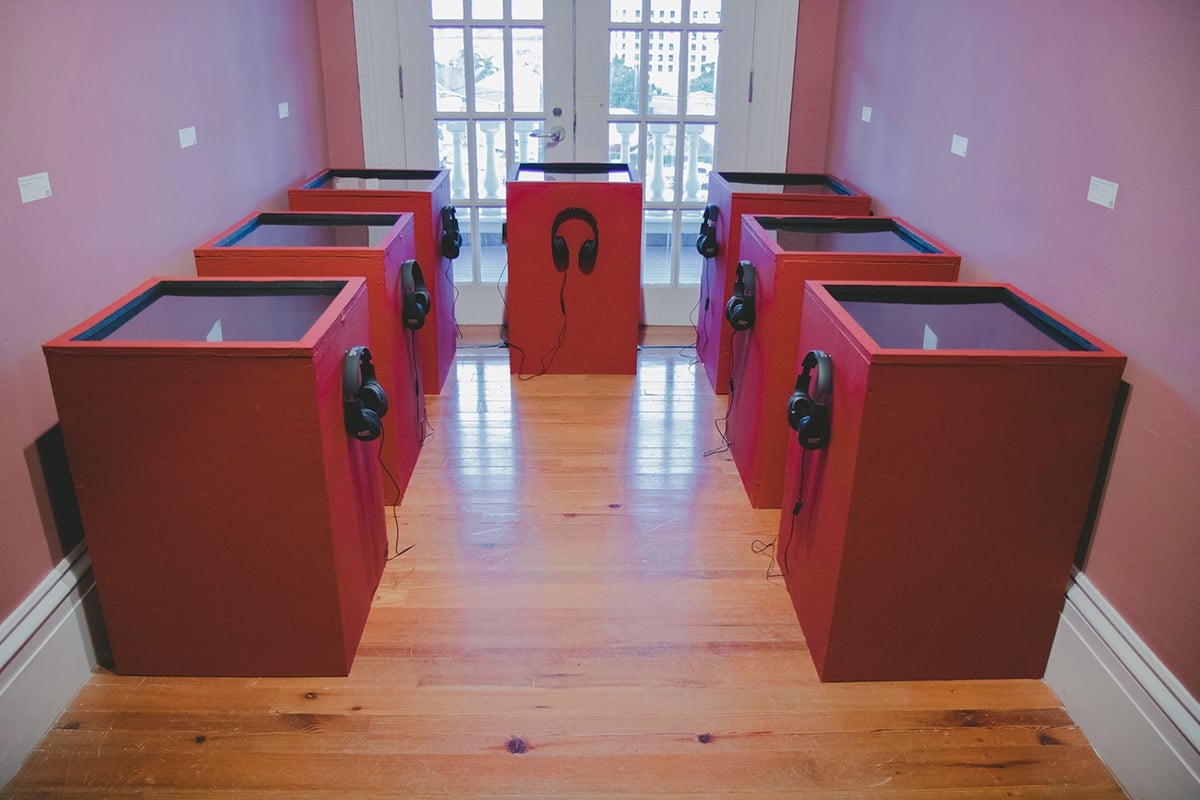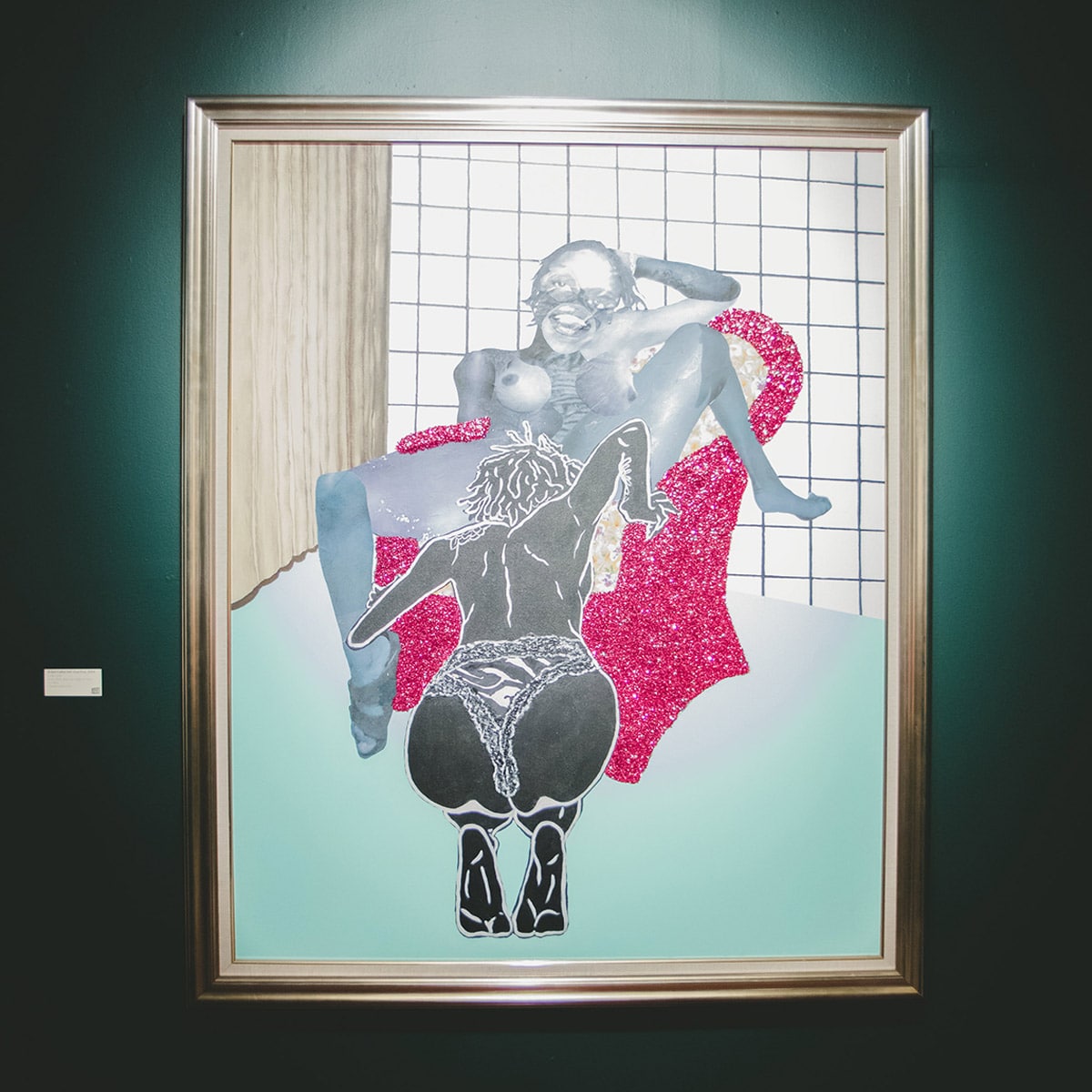
By Patricia Glinton-Meicholas
Tiffany Smith, who provided the phrase I think encompasses the better works of the exhibition, herself exemplifies the in-your-face “reclamation of the right to self-representation”. She is the ultimate tourist, hers is the “returned”, mostly unprecedented gaze upon Bahamian personhood and culture and the point of departure is worship. It is a self-love to which NAGB has dedicated an entire room. The installation consists of a film of the artist having her hair braided (a frequent pursuit of cruise tourists) and several digital photographs featuring Smith as subject and viewer, now taking possession of the gaze and turning it on its head. Her video of the ocean seems to dilute the message rather than enhance, however.
Smith’s alter ego in this goddess complex is Cydne Coleby. This artist’s twinned submissions, A God Called Self: God First and A God Called Self: Bae Eternal (2018), were a kind of circuitous “you are your own god, as manifested in your enjoyment of your sexuality.” I do absolutely love the graphic nature of her lines and believe that her skills will advance her art once her messaging is clarified by greater maturity. I note, however, that these mixed media works are a part of a growing problem that I perceive in Bahamian art, which I will touch on a little further on.
The title of Allan Jones and Rashad Leamount-Davis’ Masc Off was undoubtedly clever and certainly appropriate. I admired the duo’s intent and attempt to redefine the perception among Bahamians of how masculinity is constructed. The prevailing public view is a painfully narrow one, which demands exclusion of any society-building, refinement of sensibilities towards divergent male ecology. In this country, manhood tends to be gauged by degree of “maleness”, viewed and judged through the plantation lens—the muscled stud whose value is defined by his ability to supply seed to boost the economic assets of the estate. So often the need to flee from fatal “sissydom” and into the shelter of the accepted tenets has engendered the brutality of male-on-male violence and omni-gendered sexual abuse, which all too often afflict Bahamian urban society of today.
Nevertheless, a more advantageous choice of subjects might have provided greater integration and dynamism to support the importance of the Jones and Leamount-Davis’ message. Inadvertently, I believe, the artist pair themselves fall into cliché. Is the viewer to believe that nude bodies and intertwining of the same—sexuality—are the only focus of the homosexual male? Is this the voyeur’s view that the artists are supposed to be contesting? Would it not have been better to add images of the subjects engaged in the quotidian range of human beings—performing functions and engaged in relationships that prejudice tends to reserve for their heterosexual counterparts—job and family life in addition to demonstrating their sexual orientation?
It is noteworthy that four artists made a valiant attempt to address the “fruit” and “seed” of the theme more clearly than many others, these include: Jo Morasco, Jalan Harris, Saskia D’Aguilar and Kendra Frorup. Morasco’s attempt to integrate the colonial/plantation cotton-based exploitation resulted in three lovely woven tapestries, which were among the most eye-pleasing of the exposition. D’Aguilar and Frorup, leaning towards environmental concerns, each produced an almost ceiling to floor hanging. I was awed by the effort that must have gone into producing and/or mounting the pieces and the unusual attraction of both. It is highly likely that one or both installations will find a home in one of the cavernous spaces that only the giant resorts can supply.
Hats off for the sheer boldness of Jalan Harris’ the exploration of the theme of NE9. The vinyl on acrylic “Self-Pollination” series, is a futuristic riff on asexual reproduction, disturbing in its perceptiveness in representing the growing self-enthroned selfhood and isolationism of the 21st century.

Jalan Harris’ “Self-Pollination” series on view in the National Exhibition 9 “NE9: The Fruit and The Seed”
“The Red Thread”, the installation featuring the recorded poetry of Shivanee Ramlochan, which is of a high order and the display of Sonia Farmer’s letterpress talents tells of a great deal of thought and expenditure. The work comprises seven boxes housing audio playback equipment in their bellies and earphones, permitting attendees to listen to Ramlochan’s recorded readings of her work. Greatly of interest is the way this artist reveals the psychological dichotomy inherent in the reaction of a person who has been sexually violated. The gut-wrenching pain of the physical rape of one’s body and most personal rights is juxtaposed with a fascination for the biological elements of the violator. The poet speaks of “the sugarpress of his lips” on her nakedness, deeply contrasting “snapped cervical wires”. Such polar opposition suggests graphically that the desecration and dominance have been indelibly imprinted on the soul of the victim to be relived again and again in contradictory awe.
Melissa Alcena’s slice-of-street life digital photography varied in intent and quality, but I did like “Shanno” and “Cassell, which were strongest portraits. But where is the “seed”, where is the “fruit”?
I much appreciated the excellence of Danny Davis’s joinery (realised in two tea boxes), but I wonder if the isolation of their location in the exhibition did not hint at the curatorial staff’s realisation that the pieces would have been better served in a more appropriate forum. Save for exceptions noted earlier, the 2018 National Exhibition produced by the National Art Gallery of The Bahamas was rather more of a non-challenging pedestrian stroll than a motorised dynamic. By the latter descriptive, I refer to the electricity that delivers a punch to our sensual receptors, leaving us feeling privileged, blessed or deeply mortified to have had the opportunity to view them—that eureka/aha moment.

Sonia Farmer and Shivanee Ramlochan’s “The Red Thread Cycle”
With D’Aguilar’s work, for example, one cannot be certain as to whether the invasive royal poinciana tree (Delonix regia) is to be condemned or praised for its journey from Africa to The Bahamas and the Caribbean.
Davis’ work is similarly problematic. NAGB’s invitation to the public to attend NE9 speaks of Davis’ plan to develop “a series of tea boxes which speak towards the vestiges of colonialism and ritual making across the island archipelago.” The question is this—In assessing the boxes, would the spectator have intuited this grand intent, depending only on the unaided eye?
Coleby’s work presents a similar dilemma. As my husband and I approached the gallery on the first day we visited, we were warned of the explicit sexual nature of certain offerings. One aspect of NE9 concentration was indeed on sexuality. This was not unexpected; sexual displays can fast-track an artist to public notice and publicity. There was absolutely no need for a heads-up, however. There was little shock and less awe. What shock there was had to do with Coleby’s material focus on prurience, rather than her declared intent of reclaiming the right to self-definition.
When I consider works of explicit sexuality, I tend to compare them to David Hockney’s oeuvre, particularly the four “Love” canvases, which go beyond the “ho hum” of many modern pretenders that simply slips into tiresome pornography. A commentary on Hockney’s “The Third Love” from London’s Tate gallery, speaks of “autobiographical allusions that often refer obliquely to the artist’s homosexuality.” In such works, with clever iconography, arcane symbols, lines of poetry from the likes of America’s grand poet Walt Whitman, sharply contrasted by ‘come hither’ lines of graffiti from public lavatory walls where illicit encounters are wont to take place, Hockney plays a game of hide and seek with his audience, engaging our intellect. In so doing, he forces us to eschew comparisons with the spectacular realism of the old masters and gain a greater appreciation for the depth of expression to be found in modern artworks, whether to condemn or to praise.
Following the incursion into NE9 and a few that came before, my primary concern is the apparent and increasing banishment of emphasis on aesthetic and thought quality. It seems that beauty, striking composition, a profounder brand of interpretation, and even drawing and painting are being exiled. And, is it really necessary to employ peep-show floridity and gimmickry to attract the notice of exhibition judges?

From Cydne Coleby’s “A God Called Self” series.
I am truly pleased at the inclusion of other art forms in the national exhibition. If not controlled, though, this omnibus treatment threatens the quality of the visual arts to which I believe NAGB is dedicated. If the Gallery is so destined, shouldn’t ‘show’ take the upper hand over ‘tell’? Even more disturbing is a perceived leaning towards written psychological treatises to accord a relevance not visible in the works of all too many of the current outgrowth of artists. Perhaps, in this schizophrenic age that is to be the new yardstick. If so, let us at least require a seamless marriage between theme and execution. This is the foundation of relevance that will stand the test of time and ethnic and cultural variance.
My summary pronouncement is this: if an art exhibition is to be worthy of the descriptive “national”, it should transcend the mundane. A National Exhibition should jolt us from our aesthetic and psychological comfort zones. It should provide us with a least one powerful ‘aha’ moment that leaves us enraptured with the sheer beauty of what is mounted before us or rattled by the provocative profundity of thought that fuelled the work.
Bynoe has noted:
“For the past 15 years, the NAGB has committed itself to the nurturing and fostering of a healthy creative ecosystem, and it continues to push the frontiers and foundations of cultural value and consciousness across the nation and its diasporas.”
I agree. So, I eagerly await the next iteration of this biannual show, the continuance of which is essential to the worthwhile development of our people and state.
